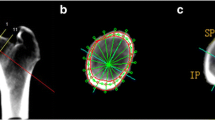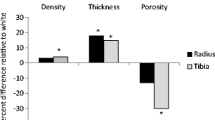Abstract
Summary
Structural skeletal differences of the femoral neck of older Beijing-Chinese and Perth-Caucasian women were compared; adjusting for frame size-related differences, Beijing-Chinese have lower periosteal width; however, indices of internal bone distribution suggest that Beijing-Chinese may exhibit increased resistance to fracture that may relate to the reduced hip fracture incidence.
Introduction
Ethnic differences in skeletal structure may relate to differences in hip fracture risk in Chinese and Caucasian populations. 2D mass, size, and structural biomechanics were compared in the two populations.
Methods
Quantitative computed tomography-derived geometric variables were compared in age-matched community-derived female populations, 196 Beijing-Chinese 76.5 ± 4.8 (mean ± SD) years and 237 Perth-Caucasians 77.1 ± 5.0 years. These included scanned area (A), periosteal width (W), bone mineral content (BMC), aBMD, bone cross-sectional area (bCSA), section modulus (Z) and buckling ratio (BR). Assumption-free measures included sigma (σ), related to the distribution of bone in the scanned image previously identified as a predictor of hip fracture, and delta (δ), the center-of-mass displacement from the geometric center.
Results
Compared to Beijing-Chinese, Perth-Caucasians were heavier (Beijing-Chinese 58.7 ± 11.8; Perth-Caucasians 66.1 ± 11.0 kg), taller (154.9 ± 16.7 vs 158.9 ± 6.0 cm), and had higher BMC, A, and W. After adjustment for frame size, BMC was not significantly different but W remained higher in Perth-Caucasians. Differences in variables aBMD, Z, BR, and σ favored higher resistance to failure with Beijing-Chinese before and after adjustment for frame size. δ was similar in both populations; bCSA was higher in Beijing-Chinese before adjustment for frame size but not after.
Conclusions
Bone mass differences in two populations were related to frame size differences. However, femoral neck width remained smaller in Beijing-Chinese suggesting effects of local genetic and environmental factors. In Beijing-Chinese participants compared to Perth-Caucasians, internal bone distribution suggests increased resistance to deformation if exposed to same force that may, in-part, relate to reduced incidence of hip fracture in Beijing-Chinese.



Similar content being viewed by others
References
Cummings SR, Melton LJ (2002) Epidemiology and outcomes of osteoporotic fractures. Lancet 359(9319):1761–1767. doi:10.1016/S0140-6736(02)08657-9
Xia WB, He SL, Xu L, Liu AM, Jiang Y, Li M, Wang O, Xing XP, Sun Y, SR C (2012) Rapidly increasing rates of hip fracture in Beijing, China. J Bone Miner Res 27(1):125–129. doi:10.1002/jbmr.519
Wang XF, Seeman E (2012) Epidemiology and structural basis of racial differences in fragility fractures in Chinese and Caucasians. Osteoporos Int : J Established Result Cooperation Eur Found Osteoporos Nat Osteoporos Found USA 23(2):411–422. doi:10.1007/s00198-011-1739-2
Cong E, Walker MD (2014) The Chinese skeleton: insights into microstructure that help to explain the epidemiology of fracture. Bone Res 2:14009. doi:10.1038/boneres.2014.9
Nelson DA, Beck TJ, Wu G, Lewis CE, Bassford T, Cauley JA, LeBoff MS, Going SB, Chen Z (2011) Ethnic differences in femur geometry in the women’s health initiative observational study. Osteoporos Int : J Established Result Coop Eur Found Osteoporos Nat Osteoporos Found USA 22(5):1377–1388. doi:10.1007/s00198-010-1349-4
Danielson ME, Beck TJ, Lian Y, Karlamangla AS, Greendale GA, Ruppert K, Lo J, Greenspan S, Vuga M, Cauley JA (2013) Ethnic variability in bone geometry as assessed by hip structure analysis: findings from the hip strength across the menopausal transition study. J Bone Miner Res 28(4):771–779. doi:10.1002/jbmr.1781
Lau EM (2009) The epidemiology of osteoporosis in Asia. IBMS BoneKEy 6(5):190–193. doi:10.1138/20090378
Beck TJ, Ruff CB, Warden KE, Scott WW Jr, Rao G (1990) Predicting femoral neck strength from bone mineral data. A structural approach. Investig Radiol 25(1):6–18
Bonnick SL (2007) HSA: beyond BMD with DXA. Bone 41(1 Suppl 1):S9–12. doi:10.1016/j.bone.2007.03.007
Khoo BC, Brown K, Zhu K, Price RI, Prince RL (2014) Effects of the assessment of 4 determinants of structural geometry on QCT- and DXA-derived hip structural analysis measurements in elderly women. J Clin Densitom 17(1):38–46. doi:10.1016/j.jocd.2013.03.009
Khoo BC, Lewis JR, Brown K, Prince RL (2016) Evaluation of a simplified hip structure analysis method for the prediction of incident hip fracture events. Osteoporos Int : J Established Result Coop Eur Found Osteoporos Nat Osteoporos Found USA 27(1):241–248. doi:10.1007/s00198-015-3282-z
Khoo BC, Brown K, Zhu K, Pollock M, Wilson KE, Price RI, Prince RL (2012) Differences in structural geometrical outcomes at the neck of the proximal femur using two-dimensional DXA-derived projection (APEX) and three-dimensional QCT-derived (BIT QCT) techniques. Osteoporos Int : J Established Result Coop Eur Found Osteoporos Nat Osteoporos Found USA 23(4):1393–1398. doi:10.1007/s00198-011-1727-6
Ramamurthi K, Ahmad O, Engelke K, Taylor RH, Zhu K, Gustafsson S, Prince RL, Wilson KE (2011) An in vivo comparison of hip structure analysis (HSA) with measurements obtained by QCT. Osteoporos Int 23(2):543–551. doi:10.1007/s00198-011-1578-1
Wang L, Cheng XG, Su YB, Brown K, Xu L, Li K, Zhang CX, Zhang Y, Duanmu YY, Wu XB, Wang MY (2017) Sex-related variations in cortical and trabecular bone of the femoral neck in an elderly Chinese population. Osteoporos Int : Journal established as result of cooperation between the European Foundation for Osteoporosis and the National Osteoporosis Foundation of the USA. doi:10.1007/s00198-017-4043-y
Teo K, Chow CK, Vaz M, Rangarajan S, Yusuf S, Group PI-W (2009) The Prospective Urban Rural Epidemiology (PURE) study: examining the impact of societal influences on chronic noncommunicable diseases in low-, middle-, and high-income countries. Am Heart J 158(1):1–7. doi:10.1016/j.ahj.2009.04.019
Khoo BC, Brown K, Cann C, Zhu K, Henzell S, Low V, Gustafsson S, Price RI, Prince RL (2009) Comparison of QCT-derived and DXA-derived areal bone mineral density and T scores. Osteoporos Int : J Established Result Coop Eur Found Osteoporos Nat Osteoporos Found USA 20(9):1539–1545. doi:10.1007/s00198-008-0820-y
Cheng XG, Wang L, Wang QQ, Ma YM, Su YB, Li K (2014) Validation of quantitative computed tomography-derived areal bone mineral density with dual energy X-ray absorptiometry in an elderly Chinese population. Chin Med J 127(8):1445–1449. doi:10.3760/cma.j.issn.0366-6999.20132915
Beck T (2003) Measuring the structural strength of bones with dual-energy X-ray absorptiometry: principles, technical limitations, and future possibilities. Osteoporos Int : J Established Result Coop Eur Found Osteoporos Nat Osteoporos Found USA 14(Suppl 5):S81–S88. doi:10.1007/s00198-003-1478-0
Thomas CD, Mayhew PM, Power J, Poole KE, Loveridge N, Clement JG, Burgoyne CJ, Reeve J (2009) Femoral neck trabecular bone: loss with aging and role in preventing fracture. J Bone Miner Res 24(11):1808–1818. doi:10.1359/jbmr.090504
Srinivasan B, Kopperdahl DL, Amin S, Atkinson EJ, Camp J, Robb RA, Riggs BL, Orwoll ES, Melton LJ 3rd, Keaveny TM, Khosla S (2012) Relationship of femoral neck areal bone mineral density to volumetric bone mineral density, bone size, and femoral strength in men and women. Osteoporos Int : J Established Result Coop Eur Found Osteoporos Nat Osteoporos Found USA 23(1):155–162. doi:10.1007/s00198-011-1822-8
Black DM, Bouxsein ML, Marshall LM, Cummings SR, Lang TF, Cauley JA, Ensrud KE, Nielson CM, Orwoll ES, Osteoporotic Fractures in Men Research G (2008) Proximal femoral structure and the prediction of hip fracture in men: a large prospective study using QCT. J Bone Miner Res : Off J Am Soc Bone Miner Res 23(8):1326–1333. doi:10.1359/jbmr.080316
Bousson VD, Adams J, Engelke K, Aout M, Cohen-Solal M, Bergot C, Haguenauer D, Goldberg D, Champion K, Aksouh R, Vicaut E, Laredo JD (2011) In vivo discrimination of hip fracture with quantitative computed tomography: results from the prospective European Femur Fracture Study (EFFECT). J Bone Miner Res 26(4):881–893. doi:10.1002/jbmr.270
Reeve J, Loveridge N (2014) The fragile elderly hip: mechanisms associated with age-related loss of strength and toughness. Bone 61:138–148. doi:10.1016/j.bone.2013.12.034
Khoo BC, Brown K, Prince RL (2016) Analysis of the change in the superior and inferior cortical structure of the female femoral neck between 19 and 97 years. J Bone Miner Res 31 (Suppl 1) Available at http://www.asbmr.org/Meetings/AnnualMeeting/AbstractDetail.aspx?aid=51d4e88b-f79d-47e2-a15b-134f0c57b52e (Accessed September 27)
Curtis E, Litwic A, Cooper C, Dennison E (2015) Determinants of muscle and bone aging. J Cell Physiol 230(11):2618–2625. doi:10.1002/jcp.25001
Byberg L, Bellavia A, Orsini N, Wolk A, Michaelsson K (2015) Fruit and vegetable intake and risk of hip fracture: a cohort study of Swedish men and women. J Bone Miner Res 30(6):976–984. doi:10.1002/jbmr.2384
Warden SJ, Fuchs RK (2009) Exercise and bone health: optimising bone structure during growth is key, but all is not in vain during ageing. Br J Sports Med 43(12):885–887. doi:10.1136/bjsm.2008.054866
Kanis JA, Johansson H, Johnell O, Oden A, De Laet C, Eisman JA, Pols H, Tenenhouse A (2005) Alcohol intake as a risk factor for fracture. Osteoporos Int : J Established Result Coop Eur Found Osteoporos Nat Osteoporos Found USA 16(7):737–742. doi:10.1007/s00198-004-1734-y
Wang XF, Wang Q, Ghasem-Zadeh A, Evans A, McLeod C, Iuliano-Burns S, Seeman E (2009) Differences in macro- and microarchitecture of the appendicular skeleton in young Chinese and white women. J Bone Miner Res 24(12):1946–1952. doi:10.1359/jbmr.090529
Acknowledgements
This work was supported by grants from the National Natural Science foundation of China (Grant no: 81071131), the Beijing Bureau of Health 215 program (Grant number: 2013-3-033; 2009-2-03), the Beijing Technology Foundation for Selected Overseas Chinese Scholar and Beijing Talents Fund (Grant no: 2015000021467), and the Capital Characteristic Clinic Project (Grant number: Z141107002514072).
Author information
Authors and Affiliations
Corresponding author
Ethics declarations
All procedures performed that involved human participants were in accordance with the ethical standards of the institutional and/or national research committee and are approved by the Institutional Review Board from the ethic committees of Beijing Jishuitan Hospital and the University of Western Australia.
Ethics approval
Perth: For the Calcium Intake Fracture Outcomes Study, the Human Ethics Committee of the University of Western Australia approved the study and written informed consents were obtained from all participants (approval number 05/06/004/H50). As this trial commenced and was completed prior to the advent of the clinical trials registry, the trial was retrospectively registered in the Australian New Zealand Clinical Trials Registry ACTRN12615000750583. For the Protein Intake Metabolic Outcomes Study, all procedures followed were in accordance with institutional guidelines and were conducted at the Sir Charles Gairdner Hospital in Perth. The study was approved by the Sir Charles Gairdner Hospital Human Research Ethics Committee, and all participants provided written informed consent. The study was conducted in compliance with the ethical principles of the Declaration of Helsinki and the International Conference on Harmonization Good Clinical Practices Guidelines and registered with the Australian Clinical Trials Registry (Registration Number ACTRN012607000163404).
Beijing: The China Action on Spine and Hip Status (CASH) study, registered in clinicaltrials.gov (NTC 01758770), is an ongoing study led by Cheng and colleagues at Beijing Jishuitan Hospital, Peking University Fourth School of Clinical Medicine, China, that utilized the large-scale population-based Prospective Urban Rural Epidemiology (PURE) population. For CASH study, the Human Ethics Committee of Beijing Jishuitan Hospital approved the study (approval number Jilunke Review No. 201512-02).
Conflicts of interest
None.
Rights and permissions
About this article
Cite this article
Wang, L., Khoo, B.C.C., Cheng, X.G. et al. Differences in femoral neck structure between elderly Caucasian and Chinese populations: a cross-sectional study of Perth–Beijing cohorts. Arch Osteoporos 12, 72 (2017). https://doi.org/10.1007/s11657-017-0366-8
Received:
Accepted:
Published:
DOI: https://doi.org/10.1007/s11657-017-0366-8




